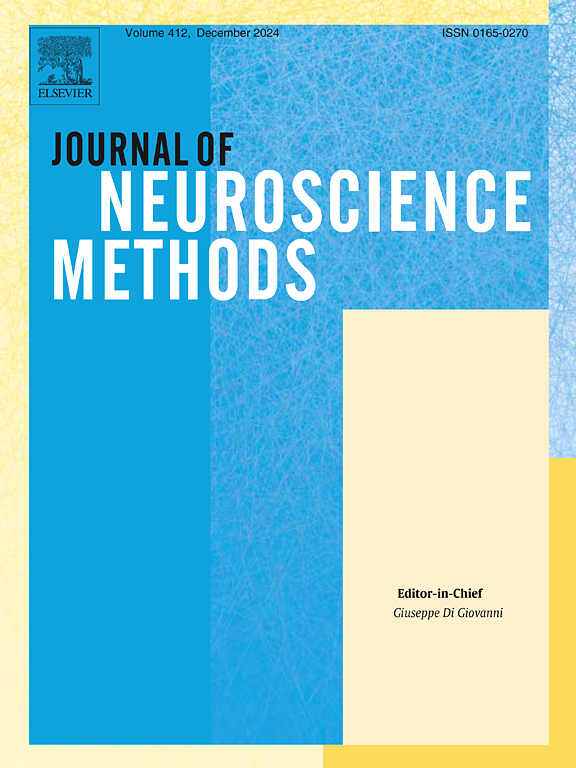Assessment of voluntary drug and alcohol intake in Drosophila melanogaster using a modified one-tube capillary feeding assay
IF 2.7
4区 医学
Q2 BIOCHEMICAL RESEARCH METHODS
引用次数: 0
Abstract
Background
The capillary feeding assay measures intakes of solutions containing ethanol and other drugs of abuse in the fruit fly Drosophila melanogaster. Existing single-tube and two-choice variations of the assay conflate drug intake with nutrient intake and utilize conditions that decrease lifespan of flies, suggesting these conditions might serve as a physiological stressor.
New method
The current experiments used a novel variation of a single-tube capillary feeding assay with flies maintained on standard, semi-soft food throughout the experiment, and offered a drug in a moderately preferred sucrose solution. Preference or aversion for a drug-containing solution was assessed relative to a control sucrose solution.
Results
We found concentration-dependent preferences for solutions containing ethanol or fencamfamine, aversions to solutions containing amphetamine, caffeine, muscimol, nicotine, pentobarbital, or picrotoxin, and a nominal aversion to solutions containing methamphetamine. Some aversions were found only in male flies, although low overall intake by female flies likely contributed to this apparent sex-specific effect.
Comparison with existing method(s)
The continuous availability of semi-soft food in our assay to decouple the need for nutrients from intake of the drug-containing solution. In addition, our assay uses only a single capillary tube per vial of flies, making it less resource intensive than two-choice capillary feeding assays.
Conclusions
The availability of standard food in our modified, one-tube capillary feeding assay should prove to be useful modification of the capillary feeding assay for studies of drug intake.
采用改进的单管毛细管喂养法评估黑腹果蝇自愿药物和酒精摄入量
背景毛细管摄食法测定了黑腹果蝇对含有乙醇和其他滥用药物溶液的摄取量。现有的单管和双管试验将药物摄入与营养摄入混为一谈,并利用降低果蝇寿命的条件,表明这些条件可能是生理应激源。新方法目前的实验采用了一种新颖的单管毛细管喂养试验,在整个实验过程中,果蝇保持在标准的半软食物上,并在中等偏好的蔗糖溶液中提供药物。相对于对照蔗糖溶液,评估对含药物溶液的偏好或厌恶程度。结果我们发现浓度依赖于对含有乙醇或苯丙胺的溶液的偏好,对含有安非他明、咖啡因、麝香醇、尼古丁、戊巴比妥或微毒素的溶液的厌恶,以及对含有甲基苯丙胺的溶液的厌恶。有些厌恶只在雄性果蝇中发现,尽管雌性果蝇的总摄入量低可能导致了这种明显的性别特异性效应。与现有方法的比较:在我们的实验中,半软食物的持续可用性将对营养的需求与含药溶液的摄入分离开来。此外,我们的测定方法每瓶苍蝇只使用一根毛细管,比两种选择的毛细管饲养测定法资源消耗更少。结论改进后的单管毛细管进样法可提供标准食品,是对毛细管进样法进行改进的有效方法。
本文章由计算机程序翻译,如有差异,请以英文原文为准。
求助全文
约1分钟内获得全文
求助全文
来源期刊

Journal of Neuroscience Methods
医学-神经科学
CiteScore
7.10
自引率
3.30%
发文量
226
审稿时长
52 days
期刊介绍:
The Journal of Neuroscience Methods publishes papers that describe new methods that are specifically for neuroscience research conducted in invertebrates, vertebrates or in man. Major methodological improvements or important refinements of established neuroscience methods are also considered for publication. The Journal''s Scope includes all aspects of contemporary neuroscience research, including anatomical, behavioural, biochemical, cellular, computational, molecular, invasive and non-invasive imaging, optogenetic, and physiological research investigations.
 求助内容:
求助内容: 应助结果提醒方式:
应助结果提醒方式:


